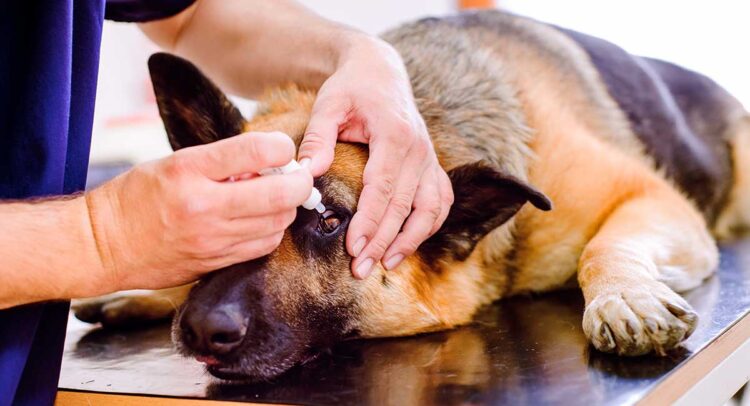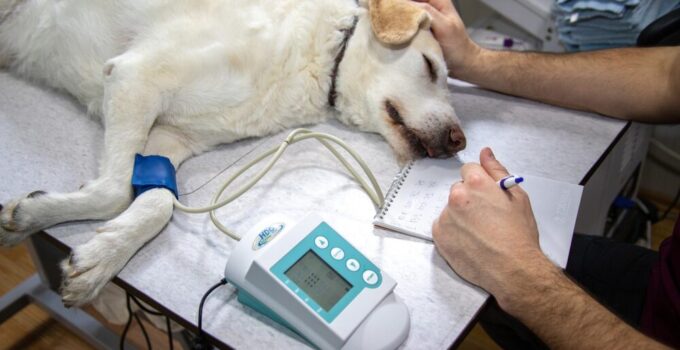What is conjunctivitis in dogs? What causes it, and how can it be treated and prevented? That’s what we are going to look at in this post.
Just like humans, our canine friends are susceptible to many health problems, including conjunctivitis. Conjunctivitis, popularly known as the pink eye, affects the conjunctiva, leading to inflammation. Much like humans, conjunctivitis can affect dogs of any age and it spread from one eye to the other. So what are conjunctivitis symptoms in dogs, and how can it be controlled? Well, read along and learn more.
Page Contents
Understanding Conjunctivitis in Dogs

Source: pixabay.com
As earlier stated, conjunctivitis is a common problem in pets as it is in humans. A study involving 31, 484 dogs found that about 3 percent of dogs in the United States had conjunctivitis. While this number might not be alarming, you surely don’t want your dog to be among those affected, do you?
Ideally, conjunctivitis affects the conjunctiva, a mucous membrane that protects the eyelids. In addition to protecting the eye, conjunctiva plays a crucial role in promoting eye movement and also helps fight infections.
Your dog will be said to have conjunctivitis when the conjunctiva becomes inflamed. Ideally, inflammation and redness occur when your dog’s body is trying to respond to an attack.
What Are the Common Causes of Conjunctivitis in Pets
Conjunctivitis in dogs can be caused by viruses, bacteria, or can even be a result of an allergic reaction. Conjunctivitis caused by allergic reactions are caused by seasonal allergies and these infections are not contagious. Causes of allergic conjunctivitis is completely dependant on the allergen. Common allergens for dogs are dust mites, pollen, harsh chemical-laden products, and others.
Both viral and bacterial conjunctivitis are highly contagious. Viral conjunctivitis is often accompanied by symptoms of cold and respiratory infection. Often the go-to treatment for viral conjunctivitis is steroid eye drops and cold compresses. For bacterial infection, which is either caused by Staphylococcus or Streptococcus bacteria vets often prescribe antibiotic eye drops.
So, What Are the Symptoms of Conjunctivitis in Dogs?

Source: petsbest.com
Conjunctivitis in dogs can exhibit various symptoms. One of the early signs of an issue can be itchiness. You may notice your dog pawing at its eyes constantly. This is usually before the redness or swelling becomes noticeable. Other symptoms may include the following.
- Redness
- Watery eyes
- Puffy eyelids
- Squinting
- Stringy discharge
- Sticky eyelids
Even so, it is essential to remember that your dog can show the above symptoms due to other reasons. It is, therefore, advisable to consult your vet anytime your dog shows such signs to help determine the type of conjunctivitis your dog is having.
If left untreated, severe cases of conjunctivitis in dogs can cause blindness to your canine friend. As a rule of thumb, avoid buying over the counter medication for your pet before the problem is diagnosed.
How to Treat Conjunctivitis in Dog
Many things will come into play before deciding the right conjunctivitis treatment for your dog, including the causes of the disease. For instance, if the condition is due to a bacterial infection or allergies, your vet may prescribe conjunctivitis ointment for dogs. For more details about eye medications and prescription pet meds check out PetCareRx.
Your vet may also recommend surgery in case of a blocked duct. Surgical removal may still be an option if they discover a tumor or traces of cancer. In the case of irritants such as cysts or ingrown hair, chemotherapy may come in handy.
On the other hand, your vet may prescribe pet medications if they notice any inflammation. In the unlikely cases, your vet may opt to remove the eyeball and the tissues surrounding it in severe cases. Depending on your dog’s medical condition, your vet may recommend further tests.
As you can see, there are various ways vets can use to treat conjunctivitis in dogs, depending on the cause of the disease. To prevent further irritation and scratching, consider buying a buster collar for your dog while recovering.
How to Prevent Conjunctivitis in Dogs

Source: thelabradorsite.com
Even if conjunctivitis in dogs is treatable and manageable, you should not wait until when your dog is infected to take action. As a responsible pet parent, you should take measures to prevent conjunctivitis before it occurs.
The first thing you can do to prevent conjunctivitis in dogs is to ensure that your dog does not miss any routine vaccinations. Among other things, this will ensure that your dog does get infections through contact with other pets.
You can also prevent viral infections by ensuring that your dog remains in your yard. To that end, you may also want to neuter your male dog if he is not meant for breeding.
Besides, you can prevent eye irritation by ensuring that the fur surrounding your dog’s eyes is trimmed. Trimming the fur around the eye is also an excellent way to protect your dog’s eyes against dust and other foreign particles that could otherwise be stuck in their coat.
You’ll also want to ensure that your dog receives regular treatment if they have a history of conjunctivitis. Also, as a rule of thumb, ensure to check your dog’s eyes more frequently so you can identify any changes. This way, you can seek veterinary advice as early as possible.
So, Can You Get Conjunctivitis Through Contact with Your Dog?
Obviously, your dog can catch conjunctivitis when they come into contact with dogs with the disease. For your dog’s safety, consider limiting the time that your dog spends outside your compound. What is of concern to most people is whether people can get conjunctivitis by coming into contact with an infected dog.
While it’s unlikely that you can get conjunctivitis from your canine friend, if the disease is due to a parasitic infection, the chances are that you can catch the disease. As such, be sure to contact your vet immediately anytime you notice any conjunctivitis signs in your dog.





